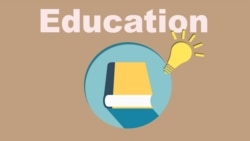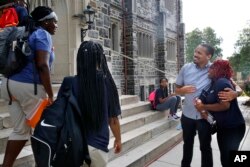Junior Alvarado was worried when he began his first year at a public charter high school in Washington, DC. He often struggled in his math classes and earned poor grades in middle school.
But the teachers at the Washington Leadership Academy used computer programs to identify the areas he was weak in and design a learning plan just for him.
As Alvarado started geometry in his second year of high school last week, he says he felt much better about his math skills.
“For me personalized learning is having classes set at your level,” the 15-year-old said, in between lessons. “They explain the problem step by step, it wouldn't be as fast. It will be at your [speed].”
Many schools in the United States struggle to raise the high school graduation rate. They also have difficulty helping many minority and low-income students perform at the same level as others. So many educators see digital technology as a way of solving these problems.
Personalized learning
The use of technology in schools is part of a larger idea of personalized learning. This idea has been gaining popularity in recent years.
Personalized learning is a way of teaching centered around the interests and needs of individual students instead of entire classes as a whole. It includes flexible learning environments, specially-designed education plans, and letting students help decide what and how they learn.
Under the Obama administration, the Education Department put $500 million into personalized learning programs in 68 school districts. These programs served almost 500,000 students in 13 states and Washington, D.C. Organizations like the Bill & Melinda Gates Foundation have also invested heavily in digital tools and other student-centered methods.
The International Association for K-12 Online Learning supports the growth of education technology. It claims that up to 10 percent of all of America's public schools now use some form of personalized learning.
Rhode Island plans to spend $2 million to become the first U.S. state to make teaching in all of its schools individualized. And current U.S. Education Secretary Betsy DeVos also supports personalized learning.
Supporters say traditional methods, where teachers just speak at the front of the class and test students all at once, do not match the modern world.
Ken Wagner is the Rhode Island Education Commissioner. He said, “The economy needs kids who are creative problem solvers, who synthesize information, [form] and express a point of view.”
At Washington Leadership Academy, educators use computer programs to collect information on students’ performance. This information helps teachers follow their students’ progress and make changes to lessons that meet students’ individual needs. That way students are able to master subjects at their own speed.
In English classes, for example, students reading below their level would have the same books or reading materials as their classmates. But complex words in the reading materials would have notes helping explain the words shown on the students’ computer screens.
Joseph Webb is the principal who helped establish the Washington Leadership Academy last year. The school serves about 200 mostly African American students from high-poverty and high-risk areas in Washington, D.C. He says the digital tools help teachers identify problems students are facing before they become too serious.
“We can [solve them] right then and there; we don't have to wait for the problem to come to us,” he said.
Too early to tell
Still, many researchers say it is too early to tell if personalized learning works better than traditional teaching.
The Rand Corporation recently did a study of personalized learning and found that it only led to small improvements. It found only a 3-percentile improvement in math and even smaller improvements in reading compared to schools with traditional teaching methods. Some students also complained group work in personalized learning classes was more difficult as each student had different tasks to complete.
In addition, experts in children’s health say the overuse of technology presents other problems. They warn that too much time looking at screens can damage face-to-face relationships and young people’s interest in physical activity.
Some teachers have their doubts as well. Marla Kilfoyle is the executive director of the Badass Teachers Association, an education activist group. She admits that technology can be helpful in the classroom in many ways. But she argues that no computer program should ever replace the personal touch, support and inspiration teachers give their students.
“That human element is very important when children learn,” Kilfoyle said.
I’m Lucija Milonig. And I’m Pete Musto.
Maria Danilova reported this story for the Associated Press. Pete Musto adapted it for VOA Learning English. Hai Do was the editor. How much technology should teachers and students use in classrooms? How important is the personal connection between teachers and students? We want to hear from you. Write to us in the Comments Section or on our Facebook page.
______________________________________________________________
Words in This Story
charter – n. a document which declares that a city, town, school, or corporation has been established
graduation – n. the act of completing an education program at a school, college, or university
income – n. money that is earned from work, investments, or business
digital – adj. using or characterized by computer technology
flexible – adj. easily changed
district(s) – n. an area or region containing the schools that a school board is in charge of
match – v. to be suited to (someone or something): to go well with (someone or something)
synthesize – v. to combine things in order to make something new
screen(s) – n. the usually flat part of a television or computer monitor that shows the images or text
complain – v. to say or write that you are unhappy, sick, uncomfortable, etc., or that you do not like something
doubt – n. a feeling of being uncertain or unsure about something
inspiration – n. something that makes someone want to do something or that gives someone an idea about what to do or create











